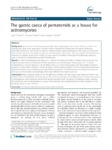Please use this identifier to cite or link to this item:
http://www.alice.cnptia.embrapa.br/alice/handle/doc/939443| Title: | The gastric caeca of pentatomids as a house for actinomycetes. |
| Authors: | ZUCCHI, T. D.  PRADO, S. de S.   CÔNSOLI, F. L.   |
| Affiliation: | TIAGO DOMINGUES ZUCCHI, ESALQ; SIMONE DE SOUZA PRADO, CNPMA; FERNANDO LUIS CONSOLI, ESALQ. |
| Date Issued: | 2012 |
| Citation: | BMC Microbiology, London, v. 12, n. 101, p. 1-7, 2012. |
| Description: | Microbes are extensively associated with insects, playing key roles in insect defense, nutrition and reproduction. Most of the associations reported involve Proteobacteria. Despite the fact that Actinobacteria associated with insects were shown to produce antibiotic barriers against pathogens to the hosts or to their food and nutrients, there are few studies focusing on their association with insects. Thus, we surveyed the Actinobacteria diversity on a specific region of the midgut of seven species of stinkbugs (Hemiptera: Pentatomidae) known to carry a diversity of symbiotically-associated Proteobacteria. |
| Thesagro: | Bactéria Percevejo |
| NAL Thesaurus: | Actinobacteria Symbiosis Biodiversity Pentatomidae |
| Keywords: | Siombiose |
| Type of Material: | Artigo de periódico |
| Access: | openAccess |
| Appears in Collections: | Artigo em periódico indexado (CNPMA)  |
Files in This Item:
| File | Description | Size | Format | |
|---|---|---|---|---|
| 2012AP35.pdf | 798.41 kB | Adobe PDF |  View/Open |









